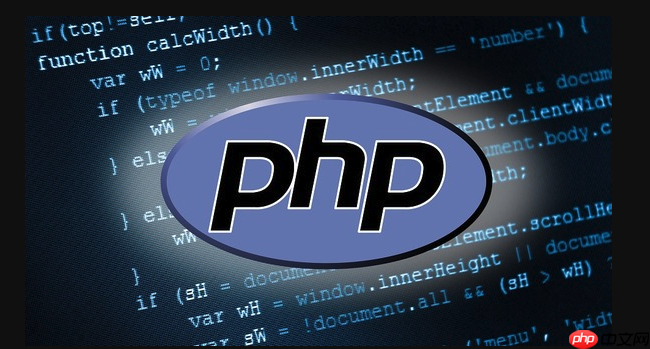Laravel验证核心是通过validate()、Validator门面或Form Request实现数据校验,保障数据完整性。常用规则包括required、email、unique等,支持自定义规则对象和扩展,验证失败后自动重定向并闪存错误信息,Web端用$errors变量展示,API返回422 JSON响应,可自定义消息提升用户体验。

Laravel Validation的核心在于它提供了一套极其强大且灵活的机制来检查输入数据的有效性,无论是通过请求实例的validate()方法,还是更高级的Form Request,抑或是直接使用Validator门面,开发者都能定义一系列规则来确保数据符合预期,从而保障应用的数据完整性和安全性。
在Laravel中进行数据验证,通常有几种主流方式,每种都有其适用场景。我个人最常用,也是最推荐的,是直接在控制器方法中使用$request->validate()。它简洁明了,对于大多数简单的验证场景来说,简直是开发效率的利器。
use Illuminate\Http\Request;
class PostController extends Controller
{
public function store(Request $request)
{
// 直接在请求实例上调用validate方法
// 如果验证失败,Laravel会自动处理错误信息并重定向回上一页
// 对于API请求,则会返回JSON格式的错误响应
$validatedData = $request->validate([
'title' => 'required|unique:posts|max:255',
'body' => 'required',
'publish_at' => 'nullable|date',
]);
// 验证通过,数据合法,可以继续处理业务逻辑
// 例如:创建新的Post
// Post::create($validatedData);
return redirect('/posts')->with('success', '文章创建成功!');
}
}当你需要更精细的控制,或者验证逻辑比较复杂,甚至需要在验证前做一些预处理时,Validator门面就显得更有用了。它允许你手动创建验证器实例。
use Illuminate\Http\Request;
use Illuminate\Support\Facades\Validator;
class UserController extends Controller
{
public function update(Request $request, $id)
{
$validator = Validator::make($request->all(), [
'name' => 'required|string|max:255',
'email' => 'required|email|unique:users,email,' . $id, // 忽略当前用户ID的邮箱
'password' => 'sometimes|min:8|confirmed', // sometimes表示只有当字段存在时才验证
]);
if ($validator->fails()) {
return redirect('user/' . $id . '/edit')
->withErrors($validator)
->withInput();
}
// 验证通过,更新用户数据
// User::find($id)->update($validator->validated());
return redirect('/users')->with('success', '用户信息更新成功!');
}
}而对于大型应用,或者说当你希望验证逻辑和控制器逻辑彻底解耦时,Form Request是我的首选。它将验证规则和授权逻辑封装在一个独立的类中,让控制器保持苗条。这块的设计,我个人觉得是Laravel在架构优雅性上做得非常出彩的地方。
// app/Http/Requests/StorePostRequest.php
namespace App\Http\Requests;
use Illuminate\Foundation\Http\FormRequest;
class StorePostRequest extends FormRequest
{
/**
* Determine if the user is authorized to make this request.
*/
public function authorize(): bool
{
// 这里可以定义用户是否有权限执行此操作的逻辑
// 例如:return auth()->user()->can('create', Post::class);
return true; // 暂时允许所有用户
}
/**
* Get the validation rules that apply to the request.
*
* @return array<string, \Illuminate\Contracts\Validation\ValidationRule|array<mixed>|string>
*/
public function rules(): array
{
return [
'title' => 'required|unique:posts|max:255',
'body' => 'required',
'publish_at' => 'nullable|date',
];
}
/**
* 自定义错误消息
*/
public function messages(): array
{
return [
'title.required' => '文章标题是必填的。',
'title.unique' => '这个标题已经有人用过了,换一个吧。',
'body.required' => '文章内容不能为空。',
];
}
}
// app/Http/Controllers/PostController.php
use App\Http\Requests\StorePostRequest;
class PostController extends Controller
{
public function store(StorePostRequest $request)
{
// 验证逻辑已经由StorePostRequest处理,如果验证失败,会自动重定向或返回JSON
// 只有当验证成功时,这里的代码才会被执行
$validatedData = $request->validated();
// Post::create($validatedData);
return redirect('/posts')->with('success', '文章创建成功!');
}
}Laravel的验证规则非常丰富,几乎涵盖了所有常见的验证场景。我个人最常用的是required、string和email,但unique和exists在处理关联数据时简直是救星,能省去很多手动查询的麻烦。这里列举一些你日常开发中会频繁遇到的核心规则,并简单说明它们的用途:
required: 字段必须存在且不为空。这是最基础也最常用的规则。string: 字段必须是字符串。integer: 字段必须是整数。numeric: 字段必须是数字(可以是整数或浮点数)。email: 字段必须是有效的电子邮件地址格式。unique:table,column,except,idColumn: 字段值在指定数据库表(table)的指定列(column)中必须是唯一的。except用于忽略特定ID的记录(更新操作时常用),idColumn指定ID列名。例如:'email' => 'unique:users,email,'.$user->id。exists:table,column: 字段值必须存在于指定数据库表(table)的指定列(column)中。这对于验证外键或关联ID非常有用。min:value: 对于字符串,表示最小长度;对于数字,表示最小值;对于文件,表示最小大小(KB)。max:value: 与min类似,但表示最大值。confirmed: 字段必须与同名字段加上_confirmation后缀的字段匹配。例如,如果你有一个password字段,那么请求中必须有一个password_confirmation字段,且两者值相同。这常用于密码确认。date: 字段必须是有效的日期格式。after:date / before:date: 字段必须在指定日期之后/之前。date可以是另一个字段名或一个日期字符串。in:foo,bar,...: 字段值必须包含在给定值列表中。not_in:foo,bar,...: 字段值不能包含在给定值列表中。alpha: 字段必须完全由字母字符组成。alpha_dash: 字段可以包含字母、数字、破折号和下划线。alpha_num: 字段可以包含字母和数字。url: 字段必须是有效的URL格式。file: 字段必须是成功上传的文件。image: 字段必须是图像(jpeg, png, bmp, gif, svg, webp)。这只是冰山一角,Laravel还提供了更多针对文件、MIME类型、IP地址、JSON等多种场景的规则。你可以通过查阅Laravel官方文档来获取完整的规则列表和更详细的用法说明。
有时候,Laravel内置的验证规则确实无法满足所有业务场景。我记得有一次,我们团队需要验证一个非常特殊的业务逻辑,比如一个用户在一个月内只能提交三次某种类型的申请,内置规则根本覆盖不了。这时候,自定义验证逻辑就显得尤为重要了。Laravel提供了几种方式来实现自定义规则,其中最灵活且推荐的是使用自定义规则对象。
1. 使用自定义规则对象 (推荐)
自定义规则对象是将验证逻辑封装在一个独立的类中,它实现了Illuminate\Contracts\Validation\Rule接口。这种方式的好处是规则可复用性高,错误消息处理也更清晰。
首先,通过Artisan命令生成一个自定义规则类:
php artisan make:rule CustomUniqueApplication
然后,编辑生成的app/Rules/CustomUniqueApplication.php文件:
namespace App\Rules;
use Closure;
use Illuminate\Contracts\Validation\ValidationRule;
use App\Models\Application; // 假设你的申请模型
class CustomUniqueApplication implements ValidationRule
{
protected $userId;
protected $applicationType;
public function __construct($userId, $applicationType)
{
$this->userId = $userId;
$this->applicationType = $applicationType;
}
/**
* Run the validation rule.
*
* @param \Closure(string): \Illuminate\Translation\PotentiallyTranslatedString $fail
*/
public function validate(string $attribute, mixed $value, Closure $fail): void
{
// 检查用户在当月内是否已经提交了三次相同类型的申请
$count = Application::where('user_id', $this->userId)
->where('type', $this->applicationType)
->whereMonth('created_at', now()->month)
->whereYear('created_at', now()->year)
->count();
if ($count >= 3) {
$fail('您本月提交此类申请的次数已达上限。');
}
}
// 如果需要更复杂的错误消息,可以在这里定义
// public function message()
// {
// return '您本月提交此类申请的次数已达上限。';
// }
}最后,在你的验证规则中使用这个自定义规则对象:
use App\Rules\CustomUniqueApplication;
class ApplicationController extends Controller
{
public function store(Request $request)
{
$userId = auth()->id(); // 获取当前用户ID
$applicationType = $request->input('type');
$request->validate([
'title' => ['required', 'string', 'max:255'],
'type' => ['required', 'string'],
'description' => ['required', 'string'],
// 使用自定义规则对象
'type' => [new CustomUniqueApplication($userId, $applicationType)],
]);
// ... 处理通过验证的申请 ...
}
}2. 使用Validator::extend方法 (简单场景)
对于一些全局性、简单的自定义规则,你可以直接在AppServiceProvider的boot方法中通过Validator::extend来扩展验证器。
// app/Providers/AppServiceProvider.php
namespace App\Providers;
use Illuminate\Support\Facades\Validator;
use Illuminate\Support\ServiceProvider;
class AppServiceProvider extends ServiceProvider
{
/**
* Register any application services.
*/
public function register(): void
{
//
}
/**
* Bootstrap any application services.
*/
public function boot(): void
{
Validator::extend('foo_bar', function ($attribute, $value, $parameters, $validator) {
// 自定义验证逻辑
// 例如:检查值是否包含 "foo" 且不包含 "bar"
return str_contains($value, 'foo') && ! str_contains($value, 'bar');
});
// 你也可以定义自定义错误消息
Validator::replacer('foo_bar', function ($message, $attribute, $rule, $parameters) {
return str_replace(':attribute', $attribute, 'The :attribute field must contain "foo" and not "bar".');
});
}
}然后,你就可以在任何地方像使用内置规则一样使用foo_bar规则了:
$request->validate([
'my_field' => 'required|foo_bar',
]);我个人觉得,虽然Validator::extend用起来很直接,但一旦验证逻辑变得稍微复杂,或者需要传递参数,自定义规则对象就显得更优雅、更易于维护。
刚开始用Laravel的时候,最头疼的就是怎么把那些验证错误信息清晰地展示给用户。后来才发现,Laravel在这方面做得简直是傻瓜式操作,$errors变量简直是神器,它会自动处理大部分情况。
1. 自动重定向与错误闪存 (Web请求)
当你使用$request->validate()或Form Request进行验证时,如果验证失败,Laravel会自动将用户重定向回上一个页面,并将所有验证错误信息闪存到session中。这些错误信息可以通过$errors变量在Blade模板中访问。
<!-- resources/views/posts/create.blade.php -->
@if ($errors->any())
<div class="alert alert-danger">
<ul>
@foreach ($errors->all() as $error)
<li>{{ $error }}</li>
@endforeach
</ul>
</div>
@endif
<form method="POST" action="/posts">
@csrf
<div>
<label for="title">标题:</label>
<input type="text" id="title" name="title" value="{{ old('title') }}">
<!-- 显示特定字段的错误信息 -->
@error('title')
<div class="text-danger">{{ $message }}</div>
@enderror
</div>
<div>
<label for="body">内容:</label>
<textarea id="body" name="body">{{ old('body') }}</textarea>
@error('body')
<div class="text-danger">{{ $message }}</div>
@enderror
</div>
<button type="submit">提交</button>
</form>$errors是一个MessageBag实例,你可以用$errors->all()获取所有错误,或者用$errors->first('field_name')获取某个字段的第一个错误。更方便的是,Blade的@error指令可以直接判断某个字段是否有错误并显示其消息。old('field_name')则用于在重定向后保留用户之前的输入,提升用户体验。
2. JSON响应 (API请求)
对于API请求,如果验证失败,Laravel会自动返回一个HTTP 422 Unprocessable Entity响应,其中包含JSON格式的错误信息。你不需要做任何额外配置,这行为是默认的。
{
"message": "The given data was invalid.",
"errors": {
"title": [
"The title field is required."
],
"body": [
"The body field is required."
]
}
}3. 自定义错误消息
你可以为每个验证规则自定义错误消息,让它们更贴近用户,更友好。
在$request->validate()或Validator::make()中定义:
$messages = [
'title.required' => '文章标题不能为空哦!',
'title.unique' => '这个标题已经被用过了,换一个吧。',
'body.required' => '文章内容是必填的。',
];
$request->validate([
'title' => 'required|unique:posts|max:255',
'body' => 'required',
], $messages);在Form Request中定义:
这是我个人觉得最整洁的方式,因为错误消息和验证规则都在同一个地方。
// app/Http/Requests/StorePostRequest.php
// ...
public function messages(): array
{
return [
'title.required' => '文章标题是必填的。',
'title.unique' => '这个标题已经有人用过了,换一个吧。',
'body.required' => '文章内容不能为空。',
'publish_at.date' => '发布日期格式不正确。',
];
}使用语言文件:
对于多语言应用,或者你希望集中管理所有错误消息,可以使用语言文件。在resources/lang/en/validation.php(或你的语言文件)中,你可以找到默认的错误消息,并可以添加或覆盖它们。
// resources/lang/en/validation.php
return [
// ...
'required' => 'The :attribute field is required.',
'unique' => 'The :attribute has already been taken.',
// ...
'custom' => [
'title' => [
'required' => 'Please enter a title for your post.',
'unique' => 'This title is already in use. Try another one.',
],
'body' => [
'required' => 'The content of the post cannot be empty.',
],
],
];通过这种方式,你可以非常灵活地控制错误信息的展示,让用户在填写表单时获得清晰、友好的反馈。
以上就是LaravelValidation怎么进行数据验证_LaravelValidation验证规则的详细内容,更多请关注php中文网其它相关文章!

每个人都需要一台速度更快、更稳定的 PC。随着时间的推移,垃圾文件、旧注册表数据和不必要的后台进程会占用资源并降低性能。幸运的是,许多工具可以让 Windows 保持平稳运行。

Copyright 2014-2025 https://www.php.cn/ All Rights Reserved | php.cn | 湘ICP备2023035733号